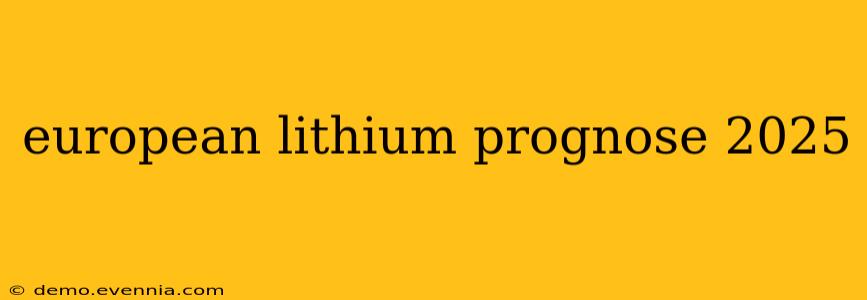The European lithium market is poised for explosive growth by 2025, driven by the burgeoning electric vehicle (EV) sector and the continent's ambitious green energy transition. This forecast delves into the key factors shaping the lithium landscape, examining production, demand, supply chain vulnerabilities, and the potential for both significant opportunities and considerable challenges.
Production Projections: Bridging the Gap Between Supply and Demand
Current lithium production within Europe is relatively limited. However, several significant projects are underway, aiming to drastically increase domestic output by 2025. These projects, encompassing hard-rock mining and brine extraction, are strategically located across several European nations. While optimistic projections exist regarding the scale of these endeavors, several factors could impact their success:
Challenges to Increased Production:
- Permitting and Regulatory Hurdles: The lengthy and complex permitting processes associated with mining operations represent a significant bottleneck. Environmental impact assessments and public consultations often lead to delays, potentially hindering the timely achievement of production targets.
- Infrastructure Development: Establishing the necessary infrastructure – including roads, power grids, and processing facilities – is crucial but can be costly and time-consuming. This is particularly true in remote locations where many lithium deposits are found.
- Community Acceptance and Social License to Operate: Securing the support of local communities is paramount to ensure the long-term viability of mining projects. Addressing concerns about environmental impacts and potential disruption is vital for gaining a "social license to operate."
- Geopolitical Risks: Geopolitical instability and potential conflicts can impact investment decisions and disrupt supply chains, adding an element of uncertainty to production forecasts.
Demand Dynamics: The EV Revolution Fuels Growth
The primary driver of European lithium demand is the rapidly expanding EV market. Stringent emissions regulations and government incentives are accelerating EV adoption across the continent, leading to a surge in battery production and, consequently, a steep rise in lithium demand. Beyond EVs, the increasing demand for energy storage solutions for renewable energy sources like solar and wind further intensifies this need.
Factors Influencing Demand:
- EV Sales Growth: The rate of EV adoption will directly impact the demand for lithium. Government policies, technological advancements, and consumer preferences will be key determinants in this area.
- Battery Chemistry Innovations: Developments in battery technology, including the exploration of alternative battery chemistries that require less lithium, could potentially moderate demand growth. However, current forecasts largely assume continued dominance of lithium-ion batteries.
- Recycling Initiatives: Increased efforts in lithium-ion battery recycling are expected to alleviate pressure on primary lithium production, but their impact by 2025 may be limited due to the relatively nascent nature of these initiatives.
Supply Chain Vulnerability: A Cause for Concern
Europe's current dependence on lithium imports from countries like Australia, Chile, and China creates vulnerability in the supply chain. This dependence exposes the continent to price volatility, geopolitical risks, and potential disruptions. Diversifying sources and bolstering domestic production are crucial to mitigate these risks.
Opportunities and Challenges: Navigating the Future
The European lithium market presents both immense opportunities and significant challenges by 2025. The successful development of domestic lithium production, coupled with strategic investment in recycling and battery technology, is crucial for ensuring a secure and sustainable supply of this vital resource. However, addressing permitting hurdles, securing community acceptance, and navigating geopolitical complexities will be essential to achieving these ambitious goals. The next few years will be critical in determining whether Europe can successfully navigate these challenges and establish itself as a key player in the global lithium market.

